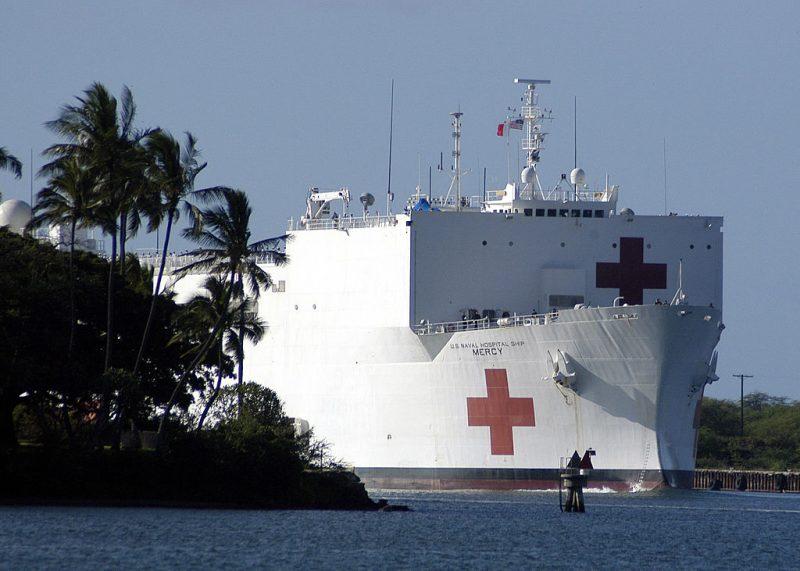Pandemics and climate change mean it’s time to consider ANZUS hospital ships
Posted By Vanessa Newby on March 30, 2020 @ 12:30

If the recent bushfire crisis and the ongoing coronavirus pandemic have taught us anything, it’s that Australia has an opportunity to evaluate its coordination on humanitarian assistance and disaster relief (HADR). The tumultuous start to 2020 presents two key lessons. Australia and its ANZUS treaty partners need to work more closely together, and non-traditional security threats need to be factored more heavily into Australia’s military strategy, particularly its naval strategy.
The ANZUS alliance gains enormous benefits from its members’ shared culture and language. Collaboration between Australia and the US is extensive, with hundreds of Australian Defence Force personnel embedded in the US military. The ANZUS states would appear to be well placed for greater collaboration on HADR activities in the Asia–Pacific. However, an investigation of the extent of cooperation [1] among their militaries reveals that, despite broadly similar regional goals and a shared need for interoperability, strategic coordination on HADR is absent. All three states are more engaged with building and maintaining individual relationships with states in the Asia–Pacific.
The failure to use ANZUS as a platform for HADR remains a puzzle from a logistical perspective, and the need for greater HADR cooperation at the military level appears to have fallen under the radar of the media, government and academics.
Cooperation on HADR may not have been seriously considered because, despite the increase in the priority given to HADR by all three national militaries, the response in Australia and New Zealand has often been more reactive than proactive. And unlike NATO, which maintains a headquarters and has a broad conception of its role as a regional security provider, the ANZUS alliance is largely viewed as a limited instrument of war-making.
The natural interoperability of ANZUS states was evident in their collaboration on fighting Australia’s recent bushfires. Firefighters from the US reported [2] that it ‘had been no trouble to assume their roles and get down to work in a new country. The incident command system used to fight fires is standardised in all of these countries.’
By its organisational nature, the military is well suited to be self-sustaining, rapidly mobile and able to coordinate complex operation in crisis, and the Australian defence community has increasingly regarded HADR as part of its strategy. Australia has participated in the Pacific Partnership—which involves the deployment into the region of units from the US Pacific Fleet with a range of government and non-government humanitarian organisations—since its formation in 2006.
Australia initially conceptualised an increase in the ADF’s humanitarian activities as part of prosecuting the war on terror. The 2013 defence white paper included HADR among the stated objectives of Australia’s amphibious capability. In the 2016 version, the importance of HADR was emphasised in the context of regional relations. In 2012 the ADF took possession of ADV Ocean Shield, a ship dedicated to HADR missions, and in 2014 and 2015 two Canberra-class multipurpose amphibious ships were acquired whose role includes HADR operations.
Natural disasters can quickly overwhelm the capabilities of local responders. Lessons learned [3] from previous disasters illustrate the need for robust command and control and communications; a medical surge capability beyond that available locally; and a fast and heavy-lift capability for evacuation, decontamination and isolation.
In the Asia–Pacific region, the use of hospital ships for HADR needs to be considered more closely. After the tsunamis in Indonesia and Japan in 2004 and 2005, the US Navy’s hospital ships Mercy and Comfort were indispensable sources of medical aid and relief. They have now been deployed to the east and west coasts of the US to assist with the coronavirus responses in New York and California.
As we are witnessing here in Europe, the capacity of local hospitals to deal with coronavirus has already been overwhelmed [4] in some countries. Although, as ASPI’s Michael Shoebridge notes [5], hotels and cruise ships may be viable quick-fix alternatives, in terms of preparedness and resilience, hospital ships are well equipped with medical teams and supplies and provide more secure isolation.
Airlift may be the fastest way to deliver medical services, but not if landing sites have been compromised, such as after an earthquake. Ships, however, can still provide supplies and facilities. During non-crisis periods, hospital ships can travel to regions in which medical facilities are limited to assist with non-urgent treatment such as immunisations and eye or dental examinations.
A general increase in the number of hospital ships capable of serving Australasia and the Asia–Pacific would be a welcome addition. As one of the region’s largest and wealthiest states, Australia should consider how its military—in particular, the navy—can be better positioned to assist with both domestic and international crises.
Article printed from The Strategist: https://aspistrategist.ru
URL to article: /pandemics-and-climate-change-mean-its-time-to-consider-anzus-hospital-ships/
URLs in this post:
[1] investigation of the extent of cooperation: https://doi.org/10.1080/10357718.2019.1693497
[2] reported: https://www.newyorker.com/news/dispatch/its-a-worldwide-problem-how-north-american-and-australian-firefighters-work-together
[3] Lessons learned: https://www.google.com/url?sa=t&rct=j&q=&esrc=s&source=web&cd=1&ved=2ahUKEwjng8nyp6boAhUsPewKHVMJDXEQFjAAegQIARAB&url=http%3A%2F%2Fwww.nids.mod.go.jp%2Fenglish%2Fpublication%2Fkiyo%2Fpdf%2F2008%2Fbulletin_e2008_6.pdf
[4] has already been overwhelmed: https://www.bbc.com/news/world-europe-51952712
[5] notes: /how-to-expand-our-capacity-to-deal-with-the-coronavirus-crisis/
Click here to print.